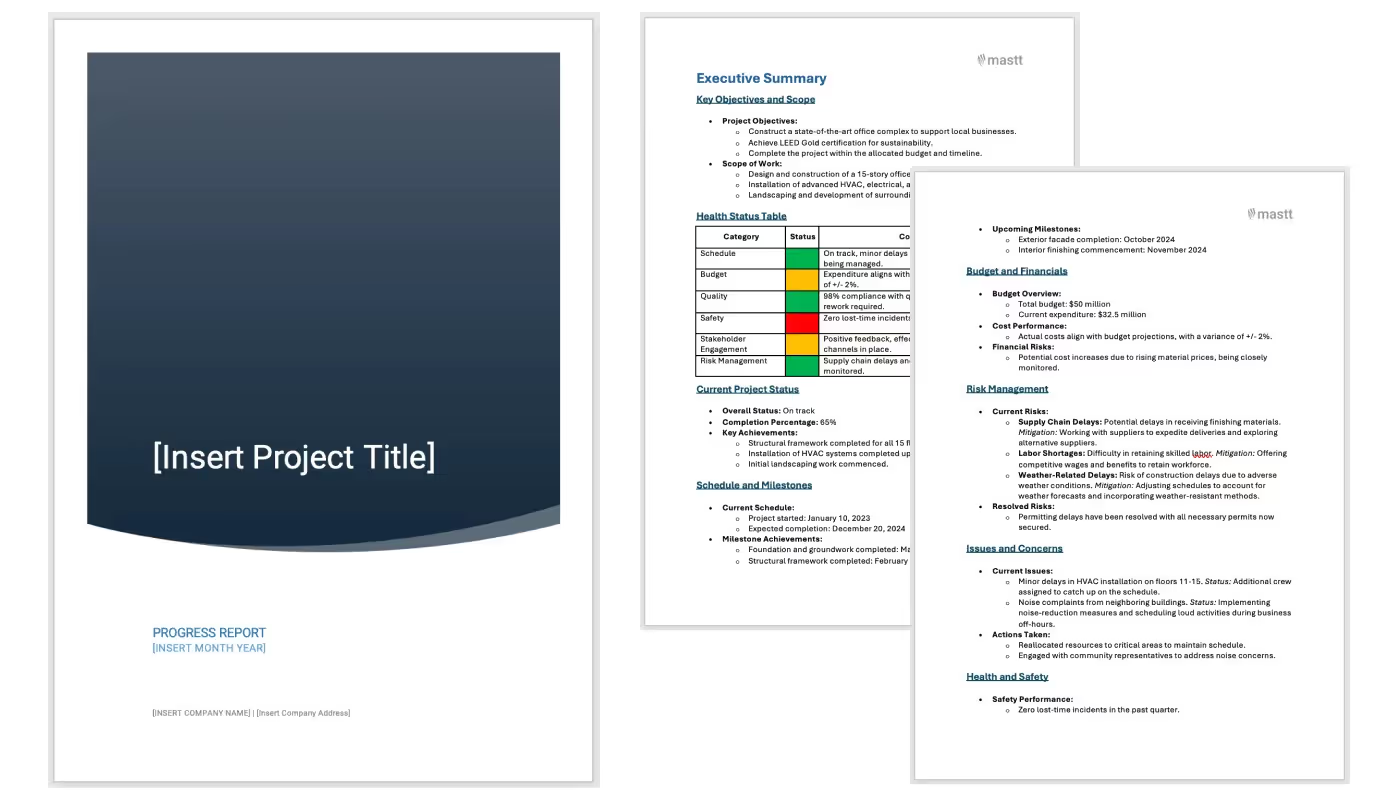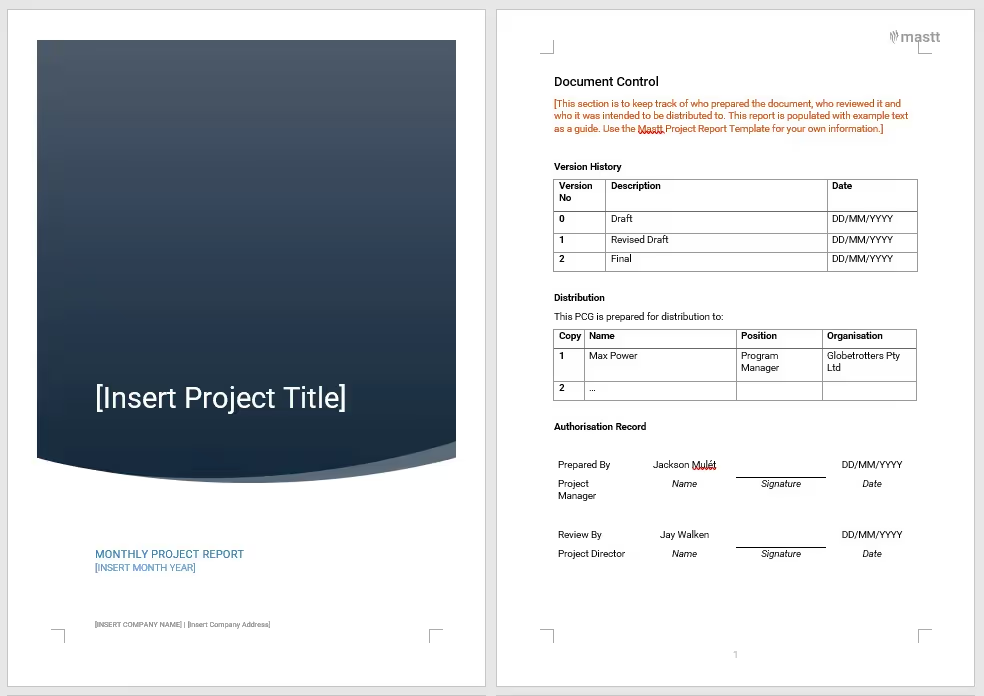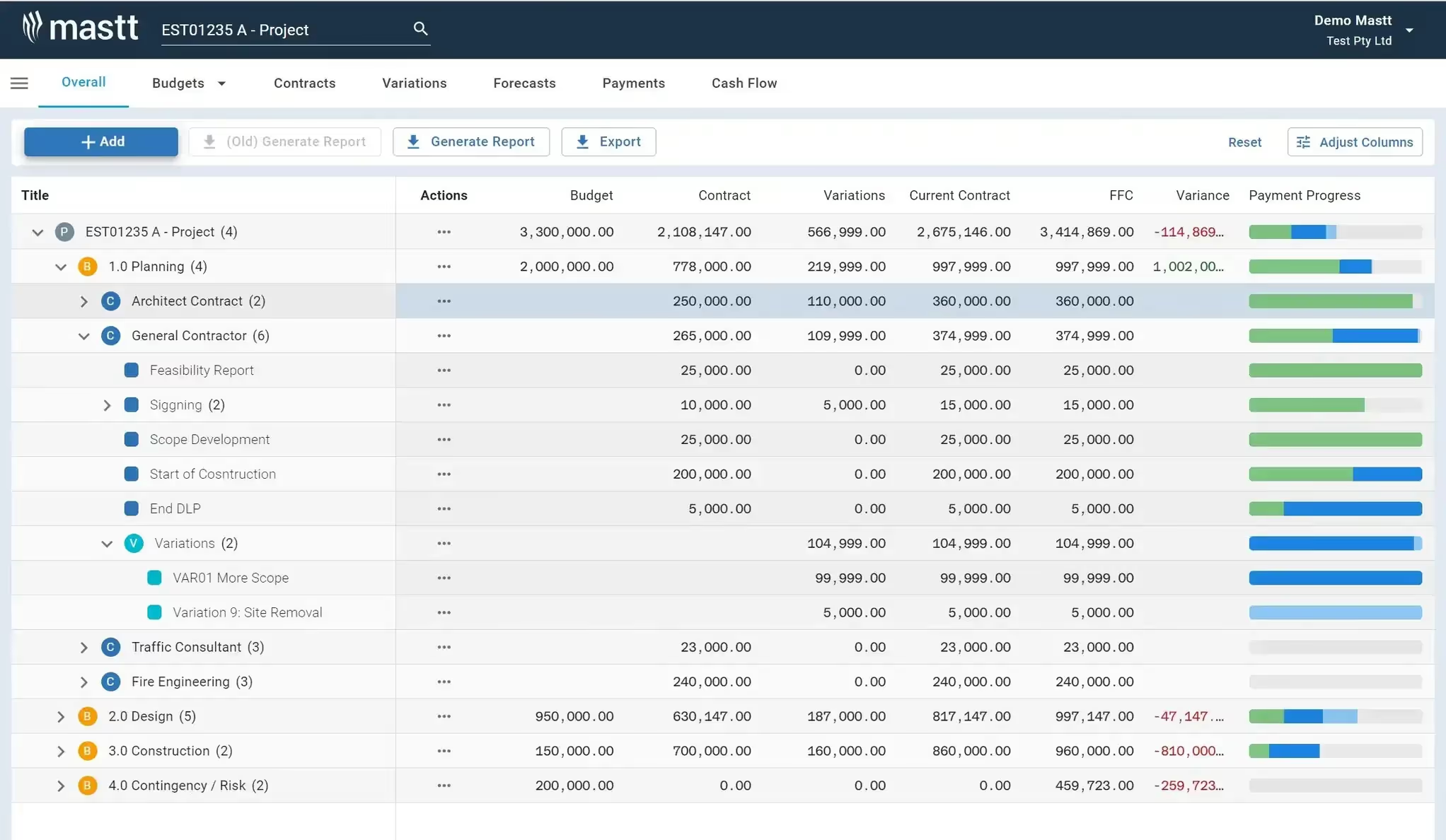In the construction industry, various types of reports play a crucial role in project management. These construction reports cater to different aspects of a project, ensuring comprehensive oversight and control.
From daily updates to final project summaries, each report serves a unique purpose and is essential for keeping the project team and key stakeholders informed.
Below is a list of the main types of construction reports used to track and manage construction projects.
1. Project Status Report
Project status reports provide an overall snapshot of the project's current state. These reports typically include:
- Current Progress: A summary of the work completed to date.
- Upcoming Milestones: Key tasks and milestones expected in the near future.
- Budget Status: Overview of the current financial situation, including spending vs. budget.
- Risk and Issues: Identification of any potential risks or ongoing issues.
- Resource Allocation: Information on how resources are being used.

Produced weekly or bi-weekly, project status reports are essential for keeping all project stakeholders informed about the project's overall health and progress. They use real-time data to provide an accurate picture, making them a critical tool in any project management arsenal.
2. Progress Report
Progress reports in construction offer regular updates on the status of project. These reports typically include:
- Completed Tasks: Details of work completed since the last report.
- Upcoming Tasks: Planned activities for the next reporting period.
- Current Status vs. Planned Schedule: Comparison of actual progress against the project schedule.
- Issues and Resolutions: Any problems encountered and the steps taken to resolve them.

These reports are usually generated weekly, bi-weekly, or monthly and are crucial for keeping stakeholders informed and tracking project milestones. Construction reports like these ensure everyone is on the same page regarding the project's progress.
3. Daily Construction Reports (DCR)
Daily construction reports (DCRs) are crucial for day-to-day management. These reports capture the daily activities on the construction site, including:
- Work Performed: A summary of the tasks completed each day.
- Labor and Equipment Usage: Details of the workforce and machinery utilized.
- Weather Conditions: Impact of weather on the day’s activities.
- Incidents and Delays: Any disruptions or incidents that occurred.

Daily on-site meetings drive success, with key discussions documented in the Daily Construction Report (DCR) to ensure transparency and progress tracking.
Construction daily field reports are vital for immediate decision-making and maintaining a daily log that can be referred to if issues arise later.
4. Monthly Report
Monthly reports provide a comprehensive overview of the project's status over a month. They typically include:
- Summary of Progress: An overview of what has been accomplished.
- Financial Status: Budget updates and cost analysis.
- Schedule Updates: Any changes to the project timeline.
- Key Issues and Resolutions: Major problems and how they were handled.

These reports are essential for higher-level stakeholders who must see the bigger picture.
5. Cost Report
Construction cost reports provide a detailed account of the financial status of a project. They include:
- Budget vs. Actual Expenditure: Comparison of planned budget against actual spending.
- Cost Variances and Reasons: Explanation of any deviations from the budget.
- Forecasted Costs to Complete: Estimates of the remaining costs needed to complete the project.

Typically produced monthly or quarterly, cost reports ensure financial control and help identify cost overruns early. Effective construction reporting on costs is critical for managing budgets and avoiding financial surprises.
6. Schedule Report
Schedule reports track the progress of the project against the planned timeline. They include:
- Planned vs. Actual Schedule: Comparison of the projected timeline with actual progress.
- Milestones Achieved: Key project milestones that have been reached.
- Upcoming Milestones: Important upcoming dates and activities.
- Delays and Adjustments: Any schedule changes and the reasons behind them.

A schedule timeline provides stakeholders with a clear, concise overview, simplifying the complexities of Gantt charts.
These reports help ensure that the project stays on track and allow for adjustments to be made proactively.
7. Quality Report
Quality reports assess the quality of work performed on the project. They cover:
- Quality Control Measures: Procedures and standards used to ensure quality.
- Inspection Results: Outcomes of inspections and tests conducted.
- Non-Conformance Reports: Document any deviations from quality standards.
- Corrective Actions Taken: Steps taken to address quality issues.
These reports are generated as needed, usually after major inspections, to ensure the project meets specified quality standards. Using construction reporting software can streamline the creation of these reports and ensure accuracy.
8. Safety Report
Safety reports document safety practices and incidents on the construction site. They include:
- Safety Inspections: Results of regular safety checks.
- Incident and Accident Reports: Details of any safety incidents or accidents.
- Safety Training Records: Documentation of safety training sessions conducted.
- Corrective Actions for Safety Issues: Measures taken to address safety concerns.

On-site accidents highlight the critical need for thorough Incident and Accident Reports to boost safety and prevent future risks.
Produced weekly or monthly safety reports to promote a safe working environment and ensure compliance with safety regulations. Regular construction reports on safety can significantly reduce workplace accidents.
9. Environmental Report
Environmental reports monitor the project's environmental impact and compliance with regulations. They include:
- Environmental Assessments: Evaluations of the project's environmental impact.
- Waste Management Records: Documentation of waste disposal and recycling efforts.
- Compliance with Environmental Regulations: Evidence of adherence to environmental laws and guidelines.
- Mitigation Measures: Steps taken to minimize environmental impact.

Excavation and construction activities must be continuously monitored and assessed to minimize environmental impact and ensure regulatory compliance.
These reports are generated as required by regulatory bodies to ensure environmental sustainability and compliance.
10. Delay Analysis Report
Delay analysis reports examine the causes and impacts of project delays. They include:
- Types of Delays: Identification of delays such as weather, supply chain issues, or other factors.
- Impact on Project Timeline: Analysis of how delays affect the overall project schedule.
- Mitigation Strategies: Plans to address and mitigate delays.

Delays are most effectively illustrated with a Gantt Chart, clearly showing slippage and its impact on the critical path.
These reports are produced as needed, typically when delays occur, to help understand and mitigate delays, keeping the project on track.
11. Risk Report
Risk management reports identify and manage potential risks to the project. They include:
- Identified Risks: List of potential risks to the project.
- Risk Assessment and Impact Analysis: Evaluation of the likelihood and impact of each risk.
- Mitigation Plans: Strategies to mitigate identified risks.
- Status of Risk Management Activities: Updates on implementing risk management plans.

Produced monthly or quarterly, these reports enable proactive risk management to avoid project disruptions.
12. Project Portfolio Report
Project portfolio reports summarize multiple projects being managed within a portfolio. They include:
- Overall Portfolio Status: Summary of the status of all projects.
- Resource Allocation: Overview of how resources are distributed across projects.
- Risk and Issue Summary: Key risks and issues affecting the portfolio.
- Financial Summary: Budget and expenditure overview for the entire portfolio.

These reports help stakeholders understand the broader context of their projects and make strategic decisions.
13. Final Project Report
Final project reports provide a comprehensive overview of the project upon completion. They include:
- Summary of Project Performance: Overall assessment of the project's success.
- Lessons Learned: Insights and lessons gained from the project.
- Final Financial Statement: Detailed account of the project's financial performance.
- Handover Documentation: Necessary documents for project handover to the client.

While a ribbon-cutting ceremony marks the physical completion, the project manager must still finalize the project with a comprehensive Final Project Report.
Generated once at project completion, these reports offer a complete overview and valuable insights for future projects.
Benefits of Using a Construction Report Software
Construction reporting software like Mastt can significantly enhance the efficiency and effectiveness of generating construction reports. These tools provide real-time data, ensuring that the project team and stakeholders have up-to-date information at their fingertips.
This real-time data integration allows for timely decision-making, crucial in keeping projects on track and within budget.
Moreover, construction reporting software can streamline the reporting process by automating data collection and report generation. This reduces the time and effort required to compile reports, freeing the project team to focus on other critical tasks.
Mastt provides reporting tools for construction projects, including progress, cost, risk, and safety reports. These tools centralize project data, improving collaboration and communication among team members and stakeholders for better project results.
Happy Reporting!
Construction project reports are crucial for effective project management and communication. Each report serves a specific purpose: to ensure that all aspects of the project are monitored and managed.
Regular and detailed reporting practices are essential for project success and stakeholder satisfaction. Construction reporting software can improve progress, cost, and quality reports for all involved.
It makes the reports more efficient, accurate, and valuable. This benefits everyone participating in the process.

























